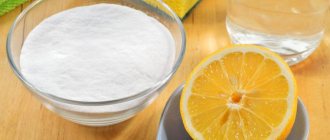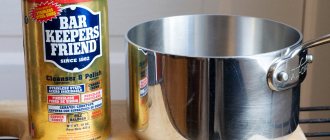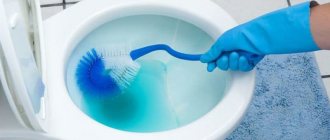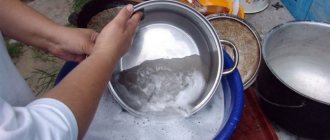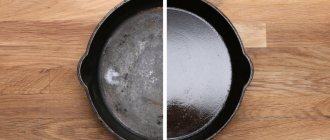A thermos is a very convenient thing for always having warm coffee or tea on hand. But if the vessel is made of stainless steel, then it absorbs various odors very strongly. And besides, tea or coffee deposits form on it. And, of course, in this case it is simply impossible to store any drinks in it. Scale, plaque and unpleasant odor from thermal containers will certainly negatively affect the taste of the drink. But this will not become a difficulty if you know how to clean the inside of a stainless steel thermos from tea deposits.
How to clean a thermos from plaque
Almost every housewife has means for cleaning the inner flask from plaque. Such substances have proven themselves to be cheap and effective detergents.
Lemon acid
The acid removes tea and coffee deposits well on the flask and adds freshness. To remove dirt:
- Pour a few tablespoons of dry matter into the flask (adjust the amount of acid depending on the volume of the thermos).
- Pour boiling water into the container.
- Close the lid tightly.
- Wait at least 15 hours, or better yet, a day.
- Drain the solution.
- Rinse the flask thoroughly with hot running water.
The procedure can be repeated if necessary.
Vinegar
Vinegar essence is great not only for cooking, but also for cleaning various objects and surfaces. To clean a thermos with vinegar:
- Fill less than half the flask with vinegar.
- Add boiling water, filling the thermos to the top.
- Cover tightly with a lid and shake well.
- Wait a few hours.
- Drain the liquid and rinse the flask with hot water until the vinegar smell goes away.
Vinegar removes black deposits and foreign odors well.
Tablets for cleaning dentures (corega)
Such preparations are used to remove food debris and plaque on dentures, so they are also perfect for cleaning a thermos.
Action plan:
- Place several tablets in the flask at the rate of 1 tablet per 500–600 ml of water.
- Pour boiling water over the contents.
- Place the thermos in the sink as the product will foam.
- Leave for several hours, or overnight if heavily soiled.
- In the next step, drain some of the liquid and scrub the inside with a sponge or brush.
- At the end of the procedure, rinse the substance with running water.
Soda
Baking soda is widely known as a universal cleansing antiseptic. To remove plaque:
- Pour a few tablespoons of soda into the flask and pour boiling water over it.
- Leave the product in the thermos for at least 5 hours, screwing the lid tightly on.
- Add a little coarse salt to the liquid and close the container again.
- Shake thoroughly and leave for another 40-60 minutes.
- As a final step, drain the cleaning solution and rinse the container.
It is known that soda actively interacts with vinegar, forming foam. A similar composition can also be used to clean a thermos. Mix 100 ml of soda and vinegar in a container and pour boiling water. Do not close the lid. A reaction will begin that will help remove the black plaque. After the procedure, be sure to rinse the flask with warm running water.
Rice
Rice is unique not only in taste, but also in physical properties. It works well as an abrasive and absorbent agent, so it is widely used for cleaning hard-to-reach surfaces. Procedure:
- Pour 100 g of rice into the flask.
- Pour boiling water over it.
- Close the lid tightly.
- Shake the thermos and let it sit for 40–60 minutes.
- During this time, shake the container periodically.
- Discard the cleaning agent and rinse the flask.
Baking powder
Baking powder contains soda and citric acid, so it is ideal for cleaning a thermos. To remove plaque:
- Pour a few tablespoons of baking powder into the container.
- Fill the substance with warm water.
- Leave the substance in the thermos for about 3 hours.
- Drain off the cleaning solution and wipe the inside surface with a brush.
- At the last stage, rinse the flask with warm water.
Brine solution (salt)
Salt does a good job of cleaning various surfaces from plaque and odors. To cleanse the inner capsule:
- Dissolve salt in water at the rate of 4 tbsp. spoons of salt per 0.5 liter of liquid.
- Pour the solution into a thermos and fill it with boiling water.
- Leave for 10–12 hours.
- Drain the mixture and rinse the flask with running water.
Salt will also perfectly clean a thermos if you mix it in a flask with small ice cubes. After mixing the ingredients, close the lid and shake the container vigorously. Leave the cleaning solution on overnight and then rinse the flask with clean water.
Coca Cola
It has long been known that carbonated drinks containing phosphoric acid perfectly remove plaque, foreign odors and dirt. Coca-Cola, Sprite or Fanta will do a good job of cleaning a thermos. To remove dirt:
- Bring the soda to a boil in a separate container.
- Pour the liquid into the flask and leave for 10–12 hours.
- Drain the substance and rinse the thermos thoroughly.
You don’t have to bring the drink to a boil, but simply pour it into a thermos and leave it warm. The result with this cleaning method will be no worse.
Bleach
Whiteness is used for washing dishes in cases where it is necessary to restore the original shining appearance, so it will also do an excellent job of cleaning the inside of the thermos.
Action plan:
- Fill the flask with a little more than half the volume of bleach.
- Add warm water to the container.
- Close the lid and shake thoroughly.
- Leave for 60 minutes and then rinse with water.
Pay utmost attention to rinsing the flask. To avoid any unpleasant odor, first wash the flask with dishwashing detergent and then rinse thoroughly with clean water several times.
Ammonia
This method is used in the most difficult cases and will require maximum ingenuity from you. You will need a plastic bottle, an awl or needle, thick thread and, of course, ammonia.
Procedure:
- Prepare in advance a plastic bottle that will be smaller in volume than a thermos.
- Make 2-3 holes in the bottle cap and thread the threads through them.
- Pour ammonia into the bottle.
- Place the ends of the threads into the flask.
- Turn the bottle upside down to create something like a dropper.
Ammonia will slowly flow down the threads, and at this time the released alcohol vapors will affect stubborn dirt.
Mustard
For cleaning you will need mustard powder. Mustard is unique in that it not only removes dirt, but also cleanses the surface of grease. To clean the inside:
- Pour 3-4 tbsp inside. spoons of mustard powder.
- Fill the flask with boiling water.
- Cover tightly and shake the mixture.
- Leave the product for 10–12 hours, and then rinse the thermos with running water.
Preventive measures
The main reason that plaque forms on the inner surface of the thermos and fungus appears is that the liquid remains in it for too long and it is not washed in a timely manner.
To avoid the need to clean a metal or glass thermos from old stains, resort to special preventive measures:
- The flask must be cleaned every time after you drink the drink, using a brush or soap.
- After this, wipe the inside and outside parts and leave until completely dry.
- Keep open.
- For preparing any drinks, use only filtered water.
- Prepare the drink separately, and only when it is ready, pour it into a thermal container.
- Do not store the drink inside for longer than one day.
If you follow these tips, you will not only avoid the appearance of complex stains, but also extend the life of your dishes. And then you won’t have to buy a special cleaning product.
Of course, nothing will help against the appearance of tea stains on the walls. He will constantly appear. But when you just see even small traces of it, it is better to wash them right away than to try to remove complex stains later. Moreover, you can only remove stubborn stains using aggressive agents.
What should not be used during washing?
It is unacceptable to use the following for washing a thermos:
- aggressive means;
- powder substances;
- technical and household cleaning assets for the kitchen;
- metal brushes and pipe cleaners;
- sand;
- crushed eggshells.
If the methods suitable for the material turned out to be ineffective, and you decide to choose prohibited cleaning methods, be extremely careful and careful during the procedure, and also strictly follow the proportions specified in the instructions.
Please note that cleaning the rubber parts of the thermos with chlorine-containing products is strictly prohibited, as is immersing them in boiling water. As a result of such procedures, the rubber may become deformed.
The simplest methods
I often remember that the new is the well-forgotten old. But some methods are so universal that from the moment they appeared, they have been used by housewives of any age group.
This fully applies to folk recipes for cleaning dishes.
- The first thing I tried was to wash the tea deposits inside the thermos with citric acid and lemon juice. Why together? Lemon juice perfectly dissolves tea leaves stains and scale, and fresh juice eliminates unpleasant odors from both metal and rubber parts of the thermos. I poured one tablespoon of acid into a one and a half liter vessel and poured boiling water over it. Tighten the cap, close the lid and shake vigorously. I left the thermos with the solution inside for 12 hours. The method worked 100% with a metal flask.
- For the glass container, I decided to use baking soda cleaning. First, I soaked a couple of tablespoons in hot water—not boiling water—and poured the mixture into a thermos. Then he repeated the shaking manipulations. This time the dishes “sodden” for almost a day. Almost all of the plaque has disappeared.
- I tried to dissolve stains from brewing with vinegar both in a thermos with a stainless steel flask and with a glass one. In the first case, I liked the effect, but the smell remained, which then had to be dissipated. In the second, I just needed to clean off what the soda didn’t take, leaving the dishes with vinegar mixed with water (1:1) for an hour.
Each method has proven its effectiveness and convenience. Personally, I think that there is not much difference between these products - except for the foreign smell from vinegar - so you can use the one that is currently on hand. It’s another matter if you want to refresh the thermos - then you can use other recipes.
Features of cleaning thermoses
When choosing the appropriate cleaning method, consider the material the flask is made of. Most often, thermos capsules are made of glass, metal or stainless steel.
Made of stainless steel
This material can withstand the effects of most cleaning agents or chemicals. The peculiarity of the material is that it is unstable to mechanical stress, so do not use abrasive substances or metal brushes and brushes for cleaning.
Glass
A glass flask is more vulnerable because, in addition to mechanical stress, it does not tolerate the influence of aggressive chemicals. To wash the glass flask, use soft substances at hand or regular dishwashing detergent.
Metal
Thermoses made of metal, with their quality characteristics, are practically not inferior to their stainless steel counterparts. Such flasks can also be cleaned with any suitable substances. The main thing is to thoroughly rinse off the cleaning composition after cleaning.
General recommendations
Stainless steel thermoses are susceptible to the formation of tea deposits, which eat into the material, making it difficult to remove. It is especially difficult to clean the inside of the product, so it is worth using some tricks for washing it. In addition, to avoid severe contamination, do not forget about the basic recommendations for operating the device.
- Wash the thermos immediately after use using soapy water and a dish brush.
- For cleaning, do not choose abrasives or brushes with metal bristles.
- Do not use bleach powders to prevent damage to the rubber parts and seams of the thermos.
- After cleaning, dry the product to avoid the appearance of an unpleasant odor or fungus.
How to remove odor
If, in addition to black deposits and dirt, the thermos has an unpleasant odor, try using substances that absorb various aromas well. These include:
- salt diluted in warm water;
- coffee beans;
- crushed lemon poured with boiling water;
- dry mustard mixed with hot water;
- Activated carbon;
- soda;
- crackers from Borodino bread.
Any of these ingredients will quickly remove the unpleasant odor in the flask.
Is it dishwasher safe?
The thermos is suitable only for delicate hand washing. Many people are interested in why it cannot be washed in the dishwasher. The answer is simple: the thermal cookware will go bad.
When washing in the dishwasher, the thermos sits in hot water for a long time. As a result, the heat-insulating material fails, so the dishes no longer retain heat. And if water gets between the body and the flask, a musty, damp smell appears.
The thermos should also not be used in microwave ovens. Plus leave it near fire and heating devices.
How to Remove Rust and Mold
If mold has formed inside the thermos during long-term storage, do not despair. You can get rid of fungus in the following way:
- Buy any dishwasher tablets in the household chemicals department.
- Treat the flask with a cleaning agent without using any mechanical influence.
- After cleaning, rinse the thermos with boiling water several times.
- Be sure to dry thoroughly after washing.
Don't forget to wash the lid of the thermos, which may also have become infected with fungus. For a more thorough clean, use an old toothbrush.
Such substances are very active, so perform the procedure very carefully and carefully. To prevent mold from appearing in the future, always rinse and dry the flask well, and do not close the lid if there is moisture left inside.
It happens that when a thermos is used for a long time, rust appears inside the flask. To remove corrosion, use any acidic product such as citric acid, vinegar or carbonated drink. After the procedure, be sure to rinse the flask with a soda solution, rinse under running water and dry thoroughly.
Types of pollution
Over time, a persistent coating from your favorite drink or even mold appears on your brand new thermos. This is not pleasing to the eye and is harmful to health. Why is this happening?
Tea and coffee stains
A cup of hot drink pleasantly warms you up in the cold. But with constant use of the thermos, an unpleasant brown film appears inside. It is formed due to caffeine and essential oils.
Scale
Hard water and insufficient care lead to limescale deposits inside the thermos. It may contain deposits of chlorine, heavy metals, bacteria, so it is better to clean it.
Mold (fungus)
Sometimes when dishes are stored closed for a long time, mold develops. Fungus appears especially often when a thermos is still damp.
Mold has an unpleasant appearance and smell and spoils the taste of drinks and food. It can cause an allergic reaction and poisoning, so you need to get rid of it.
Helpful information
Tips that will be useful to all owners of thermopots:
- When processing the device, do not use metal sponges or sharp objects. They can damage the inner surface of the device.
- Preventive cleaning is carried out at least once a month. Folk remedies are used for this purpose.
- In order to remove a thick layer of scale, they resort to the help of professional household chemicals.
- If cleaning liquid has been poured into the device, household members must be informed about this in order to avoid accidental poisoning.
- After completing cleaning, it is better not to just rinse the device, but to boil it. The first water is not used for drinking, it is drained.
You can learn about descaling from various household appliances here.
